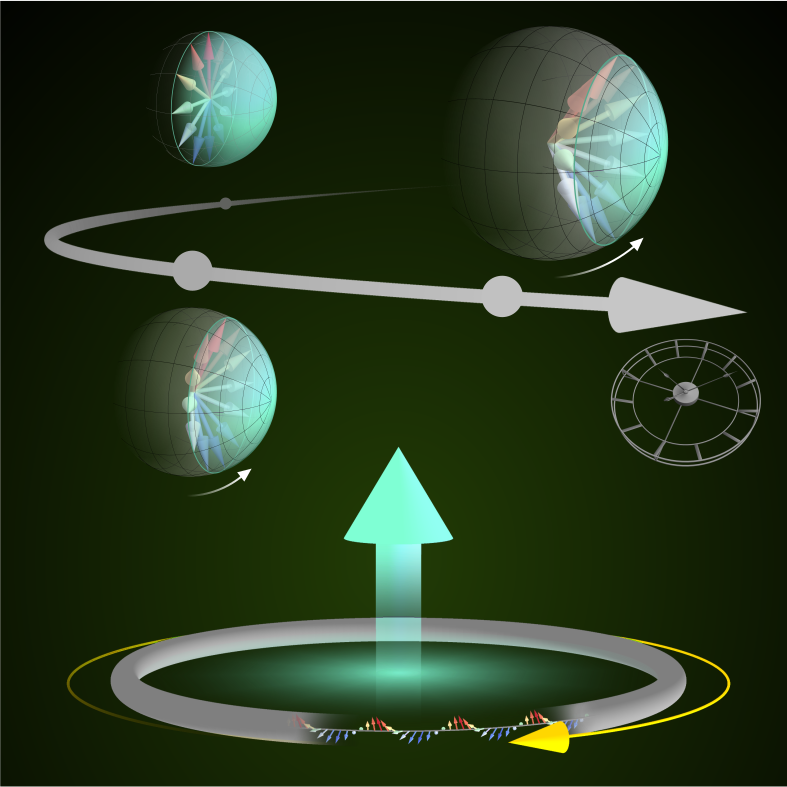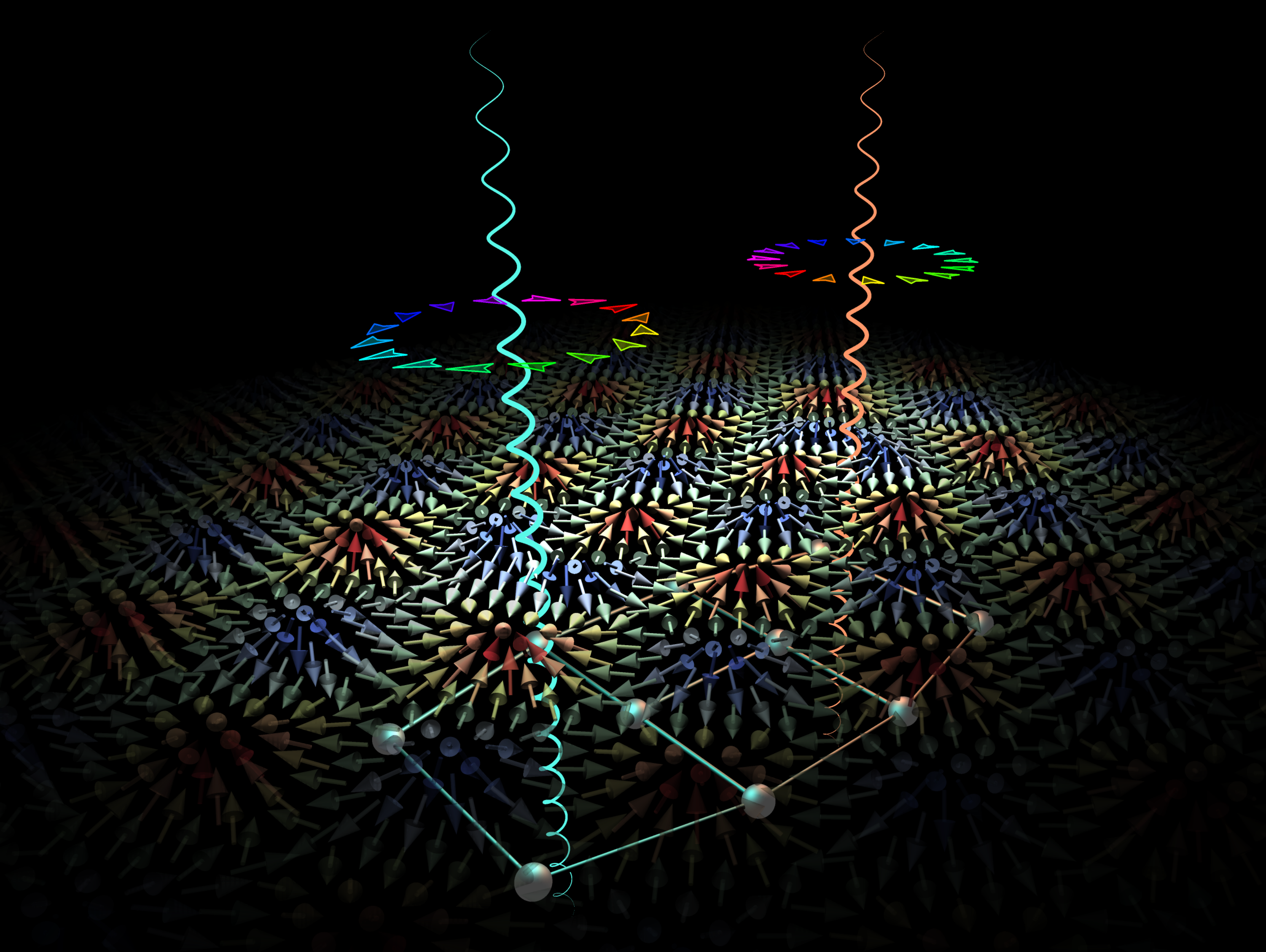About Me
Postdoctoral researcher in Condensed Matter Physics

-
Name: Kotaro Shimizu

- Age: 27
-
- Current Affiliation
-
Group: Arita Group (First-Principles Materials Science Research Team)
Center: Center for Emergent Matter Science (CEMS)
Institution: RIKEN
Country: Japan
Location:
Main Research Bldg.
Hirosawa 2-1, Wako,
Saitama 351-0198, Japan
Email:
kotaro.shimizu[!at!]riken.jp
What's new
-
2024/4/1Major Updateupdate my affiliation
Research interest
I have studied topological spin textures and related emergent electromagnetic phenomena in magnets. Among several topological spin textures, I have focused on two-dimensional magnetic skyrmion lattices and three-dimensional magnetic hedgehog lattices. For these spin textures, I have investigated a comprehensive way to generate and control the topological spin textures. I have clarified the emergent electromagnetic field acting on conduction electrons through the Berry phase mechanism and discussed resultant electromagnetic phenomena such as quantum transport properties.
My current interest lies in topology and nonequilibrium phenomena in itinerant magnets, including:
- Creation, annihilation, and control of topological spin textures (magnetic skyrmion, magnetic hedgehog, and magnetic hopfion)
- Dynamics of spin textures in an external field and an electric current
- Emergent electromagnetic phenomena in noncolinear and noncoplanar spin textures
- Topological electronic structures in magnets
- Linear and nonlinear electronic responses
Recent Projects (click to expand)
Spin Moiré Engineering
Control of spin textures, topology, and the emergent electromagnetic field


Spin Moiré Engineering of Topology and Emergent Electromagnetism
Most of the topological spin textures are commonly described by superpositions of multiple spin density waves, e.g., spin helices, and are called multiple-Q spin textures. To discuss the generation and control of these spin textures in a comprehensive way, we proposed the “spin moiré” picture for the multiple-Q spin textures, in analogy with the moiré in optics. Specifically, we introduced several different parameters to control the “moiré” patterns of spins, such as the amplitudes of superposed spin helices[4], the twist angles between the helical directions[3], and the relative phases of the helices[1,2]. We elucidated not only the modulations of the spin textures but also the evolution of the topological properties and the emergent electromagnetic fields.
-
K. Shimizu, S. Okumura, Y. Kato, and Y. Motome,
“Phase degree of freedom and topology in multiple-Q spin textures”,
Phys. Rev. B 105, 224405 (2022).
-
K. Shimizu, S. Okumura, Y. Kato, and Y. Motome,
“Phase shift, ellipticity, angle, and topological number in skyrmion lattices”,
J. Phys.: Conf. Ser. 012069, (2022).
-
K. Shimizu, S. Okumura, Y. Kato, and Y. Motome,
“Spin moiré engineering of topological magnetism and emergent electromagnetic fields”,
Phys. Rev. B 103, 184421 (2021).
-
K. Shimizu, S. Okumura, Y. Kato, and Y. Motome,
“Phase transitions between helices, vortices, and hedgehogs driven by spatial anisotropy in chiral magnets”,
Phys. Rev. B 103, 054427 (2021).

Emergent Electric Field in Helical, Conical, and Chiral Soliton Lattice
A one-dimensional spin texture such as a helical spin structure is topologically trivial, and furthermore, the emergent magnetic field is absent in continuum space. Meanwhile, the emergent electric field (EEF) accompanied by the spin dynamics still causes the emergent phenomena. We studied the EEF associated with the resonant dynamics and clarified that the solitonic features in spin textures amplify the EEF [1]. Furthermore, we found the edge mode emerging in the open boundary condition also generates the EEF, whose amplitude can be comparable to those of the bulk modes. Through the systematic study, we also discussed the possible emergent electric phenomena in a one-dimensional magnet.

Crystallization dynamics of the skyrmion lattice in frustrated metallic magnets
Magnetic skyrmions are topological spin textures in a two-dimensional magnet, and have been attracted much attention as a candidate for next-generation magnetic memory devices. Although there have been intensive studies on the skyrmion lattice (SkL), the crystallization dynamics have not been fully understood thus far. In this work, we theoretically investigated the crystallization dynamics of the SkL in a frustrated metallic magnet [1] by performing large-scale Landau-Lifshitz-Gilbert dynamics simulations based on the effective spin model for metallic magnets [2]. We found that in the formation of the square SkL viewed as a superposition of two magnetic stripes, the initial fast crystallization of skyrmions is followed by a slow relaxation dominated by the annihilation dynamics of dislocations, which are topological defects of the constituent magnetic stripe orders. We also showed that the annihilation of dislocations follows a power-law time dependence with a logarithmic correction that depends on magnetic fields. Furthermore, we clarified that the effective spin Hamiltonian can be mapped to the XY model exhibitting the similar phase ordering dynamics accompanied by pair annihilation of vortices. Our work sheds new light on the fundamental subject of 2D crystallization dynsmics and provides a new perspective on the non-equilibrium phenomena of topological spin crystals.
-
K. Shimizu and G.-W. Chern,
“Crystallization dynamics of magnetic skyrmions in a frustrated itinerant magnet”,
arXiv:2305.16182 (2023).
- S. Hayami, R. Ozawa, and Y. Motome, "Effective bilinearbiquadratic model for noncoplanar ordering in itinerant magnets", Phys. Rev. B 95, 224424 (2017); S. Hayami and Y. Motome, "Néel- and Bloch-Type Magnetic Vortices in Rashba Metals", Phys. Rev. Lett. 121, 137202 (2018); S. Hayami and Y. Motome, "Topological spin crystals by itinerant frustration", J. Phys.: Cond. Mat. 33, 443001 (2021).
Vita
Degrees and Theses
Ph. D. in Engineering
Mar. 2024
Department of Applied Physics, The University of Tokyo
director: Prof. Yukitoshi Motome
thesis: Spin moiré engineering and emergent electromagnetism in topological spin crystals
Master of Engineering
Mar. 2021
Department of Applied Physics, The University of Tokyo
director: Prof. Yukitoshi Motome
thesis: Theoretical study on control of topological spin textures based on spin moiré picture
Bachelor of Science
Mar. 2019
Department of Physics, Waseda University
director: Prof. Masahito Mochizuki
thesis: Theoretical study on slit experiments in Rashba electron systems
Experience
Special Postdoctoral Researcher (SPDR)
Apr. 2024 - Present
Arita group, Center for Emergent Mattar Science, RIKEN
JSPS Research Fellowships for Young Scientists (DC1)
Apr. 2021 - Mar. 2024
Motome group, Department of Applied Physics, The University of Tokyo
Grants
Scholarship
Honors and Awards
- Dean's Award, Graduate School of Engineering, The University of Tokyo, March 2024.
- Most outstanding presentation award for young researchers in 16th Joint Research Meeting of MEXT National Projects on Condensed-Matter Science, November 2022.
- Student Presentation Award in the Physical Society of Japan 2021 Autumn Meeting, The Physical Society of Japan, October 2021.
- Dean's Award, Graduate School of Engineering, The University of Tokyo, March 2021.
- Outstanding Master Thesis Award of the Applied Physics Department, Department of Applied Physics, The University of Tokyo, March 2021.
Publication & Presentation
Publication
click to show
Preprint
-
K. Shimizu, V. Y. Okubo, R. Knight, Z. Wang, J. Burton, H. Y. Kim, G.-W. Chern, B. S. Shivaram,
“Machine Learning Assisted Characterization of Labyrinthine Pattern Transitions”,
arXiv:2311.10558 (2023).
-
K. Shimizu and G.-W. Chern,
“Crystallization dynamics of magnetic skyrmions in a frustrated itinerant magnet”,
arXiv:2305.16182 (2023).
FY2020-
-
K. Shimizu, S. Okumura, Y. Kato, and Y. Motome,
“Emergent electric field from magnetic resonances in a one-dimensional chiral magnet”,
Phys. Rev. B 108, 134436 (2023).
-
K. Shimizu, S. Okumura, Y. Kato, and Y. Motome,
“Phase degree of freedom and topology in multiple-Q spin textures”,
Phys. Rev. B 105, 224405 (2022).
-
K. Shimizu, S. Okumura, Y. Kato, and Y. Motome,
“Spin moiré engineering of topological magnetism and emergent electromagnetic fields”,
Phys. Rev. B 103, 184421 (2021).
-
K. Shimizu, S. Okumura, Y. Kato, and Y. Motome,
“Phase transitions between helices, vortices, and hedgehogs driven by spatial anisotropy in chiral magnets”,
Phys. Rev. B 103, 054427 (2021).
-
K. Shimizu and M. Mochizuki,
“Theoretical study on slit experiments in Rashba electron systems”,
Phys. Rev. B 101, 045301 (2020).
Presentation
click to show
International conference
FY2023
- K. Shimizu, S. Okumura, Y. Kato, and Y. Motome, “Emergent electric fi eld in a one-dimensional chiral magnet driven by an AC magnetic field”, International Conference on Strongly Correlated Electron Systems 2023 (SCES 2023), MonPA2:2.06, Amsterdam, Netherlands, July 2022, poster.
FY2022
- K. Shimizu, S. Okumura, Y. Kato, and Y. Motome, “Phase degree of freedom and topological properties of multiple-Q spin textures”, American Physical Society March Meeting 2023, K54.06, Las Vegas, USA, March 2023.
- K. Shimizu, S. Okumura, Y. Kato, and Y. Motome, “Phase degree of freedom and topological properties in multiple-Q spin textures”, International Conference on Strongly Correlated Electron Systems 2022 (SCES 2022), MonPA2:2.06, Amsterdam, Netherlands, July 2022.
- K. Shimizu, S. Okumura, Y. Kato, and Y. Motome, “Spin moiré engineering of topology and emergent electromagnetic fields in multiple-Q spin textures”, 11th International Conference on Highly Frustrated Magnetism 2022 (HFM22), Paris, France, June 2022.
FY2021
- K. Shimizu, S. Okumura, Y. Kato, and Y. Motome, “Phase degree of freedom and topological properties of multiple-Q spin textures”, International Conference on Strongly Correlated Electron Systems 2020/21 (SCES 2020/21), online, Brazil, October 2021.
FY2020
- K. Shimizu, S. Okumura, Y. Kato, and Y. Motome, “Spin Moiré Engineering of Emergent Electromagnetism”, APS March meeting 2021, online, March, 2021.
- K. Shimizu, S. Okumura, Y. Kato, and Y. Motome, “Phase transitions between helices, vortices, and hedgehogs in chiral magnets by controlling spatial anisotropy”, Quantum Complex Matter 2020, online, June 2020.
Domestic conference
FY2022
- K. Shimizu, S. Okumura, Y. Kato, and Y. Motome, “Spin moiré superstructure: Analysis of topological phases brought by phase shift based on hyperspace representation”, 2022 16th Joint Research Meeting of MEXT National Projects on Condensed-Matter Science, online, Japan, November 2022, in Japanese. [selected as most outstanding presentation award for young researchers]
- K. Shimizu, S. Okumura, Y. Kato, and Y. Motome, “Emergent electric field around the edges of one-dimensional chiral magnets”, The Physical Society of Japan Autumn Meeting 2022, 13pW641-4, Tokyo, Japan, September 2022, in Japanese.
- K. Shimizu, S. Okumura, Y. Kato, and Y. Motome, “Edge effect on magnetic excitations in one-dimensional chiral magnets”, The Physical Society of Japan Autumn Meeting 2022, 13pW641-5, Tokyo, Japan, September 2022, in Japanese.
- K. Shimizu, S. Okumura, Y. Kato, and Y. Motome, “AC magnetic field drive of screw spin textures in one-dimensional chiral magnets”, The Physical Society of Japan Autumn Meeting 2022, 13pW641-6, Tokyo, Japan, September 2022, in Japanese.
FY2021
- K. Shimizu, S. Okumura, Y. Kato, and Y. Motome, “Theoretical study on the emergent electric field in one-dimensional chiral magnets”, The Physical Society of Japan 2022 Annual (77th) Meeting, 16aT31-11, online, March 2022, in Japanese.
- K. Shimizu, S. Okumura, Y. Kato, and Y. Motome, “Topological phase transition associated with phase degree of freedom in three-dimensional multiple-Q spin textures”, The Physical Society of Japan 2021 Autumn Meeting, 21pC1-3, online, Japan, September 2021, in Japanese.
- K. Shimizu, S. Okumura, Y. Kato, and Y. Motome, “Phason in multiple-Q topological spin textures”, The 2nd QLC young colloquium, online, Japan, April 2021, in Japanese.
FY2020
- K. Shimizu, S. Okumura, Y. Kato, and Y. Motome, “Phason in multiple-Q topological spin textures”, The Physical Society of Japan 2021 Annual (76th) Meeting, 12aC1-6, online, Japan, March 2021, in Japanese.
- K. Shimizu, S. Okumura, Y. Kato, and Y. Motome, “Emergent electromagnetic field and topological transition in spin moiré”, 2020 14th Joint Research Meeting of MEXT National Projects on Condensed-Matter Science, online, Japan, December 2020, in Japanese.
- K. Shimizu, S. Okumura, Y. Kato, and Y. Motome, “Emergent electromagnetic field and topological transition in spin moiré”, QLC Quantum Materials Forum, online, Japan, October 2020, in Japanese.
- K. Shimizu, S. Okumura, Y. Kato, and Y. Motome, “Spin Moiré engineering of emergent electromagnetism and topological transitions”, The Physical Society of Japan 2020 Autumn Meeting, 11pH2-2, online, Japan, September 2020, in Japanese.
- K. Shimizu, S. Okumura, Y. Kato, and Y. Motome, “Phase transitions between helices, vortices, and hedgehogs in chiral magnets driven by spatial anisotropy”, The Physical Society of Japan 2020 Autumn Meeting, 8aC1-3, online, Japan, September 2020, in Japanese.
FY2019
- K. Shimizu and M. Mochizuki, “Theory of double-slit experiments in the Rashba electron systems”, The Physical Society of Japan 2019 Autumn Meeting, 10aD15-7, Gifu, Japan, September 2019, in Japanese.


